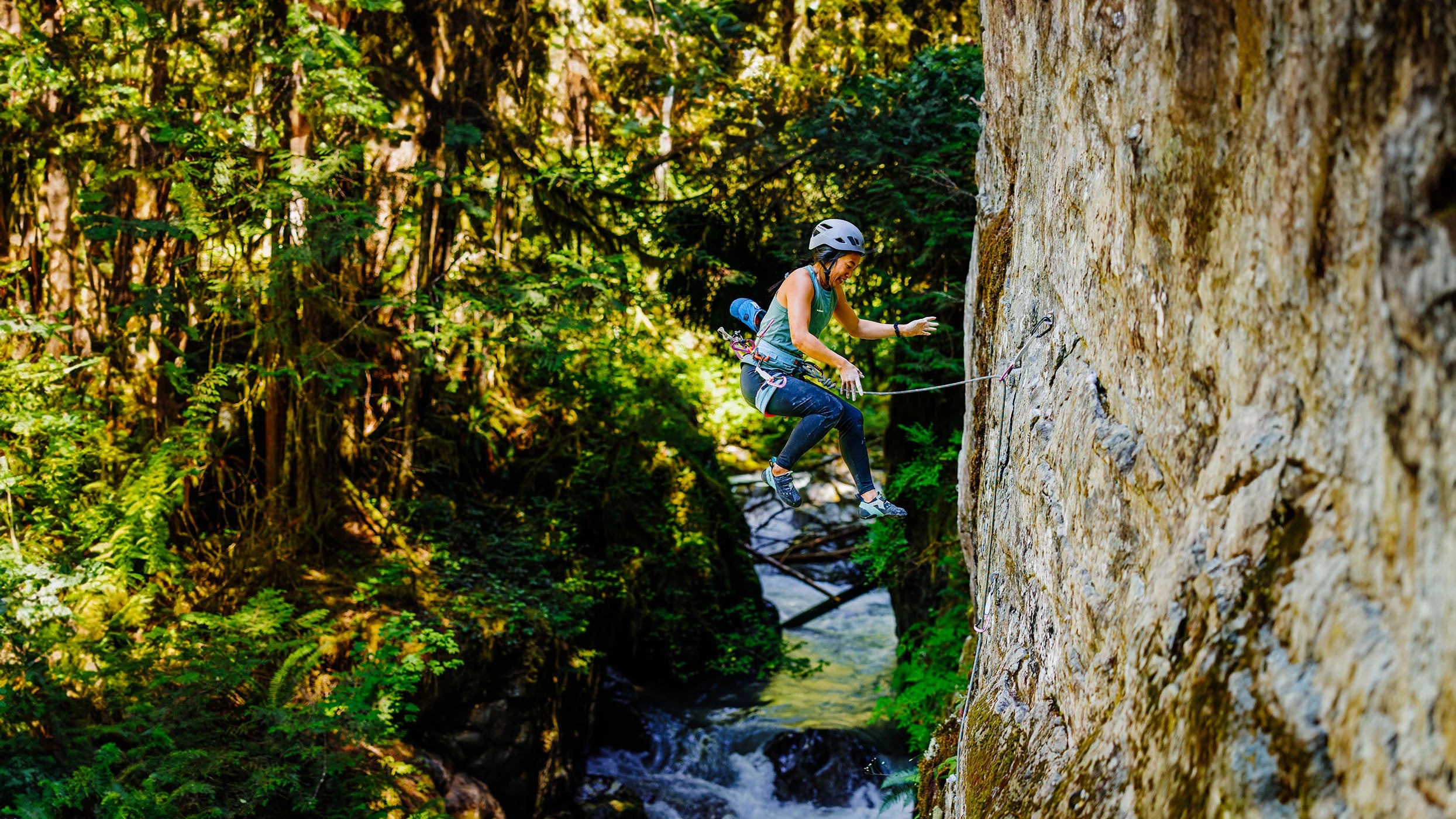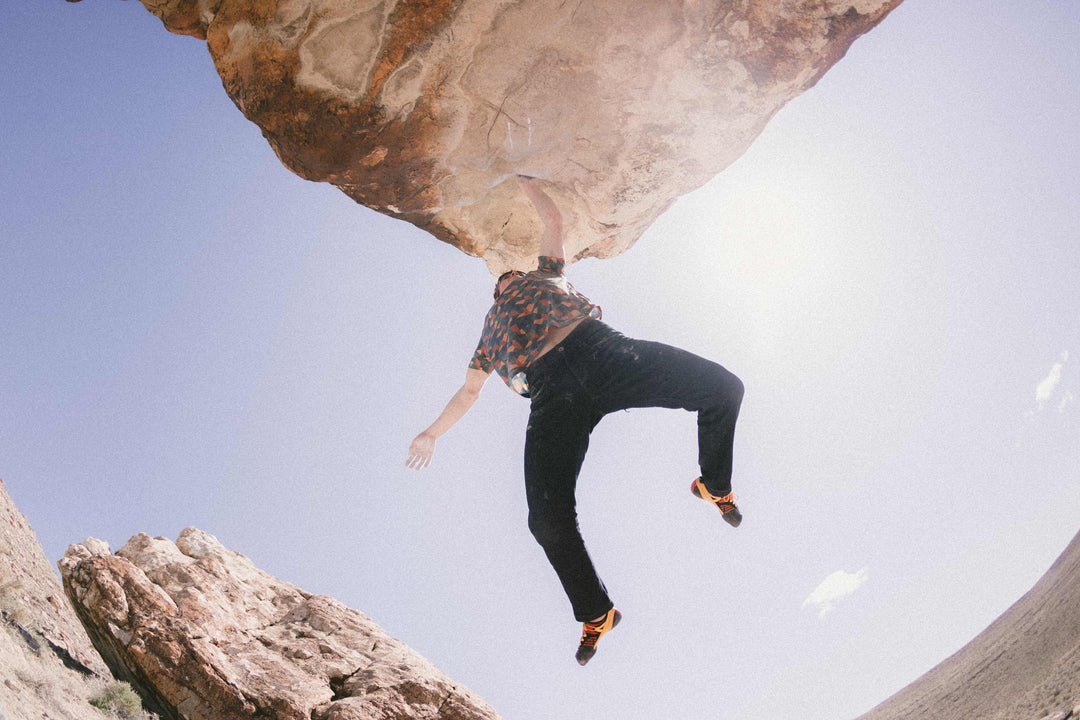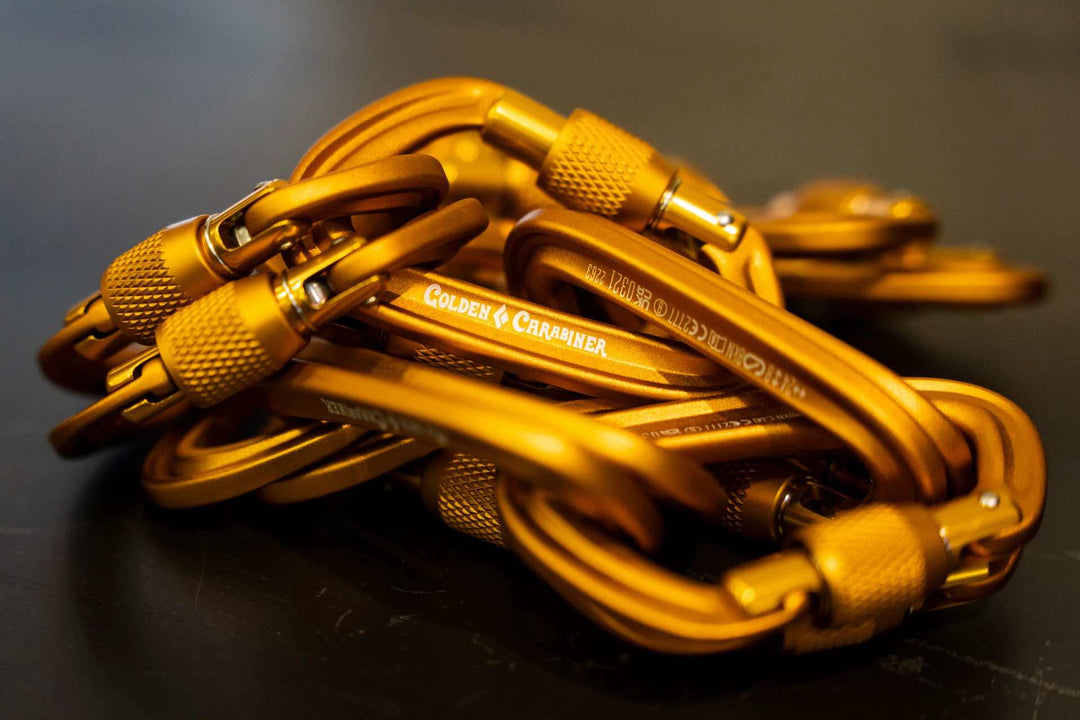The Ultimate Everything Climbing Shoe Fit Guide
Whether you're a beginner or a seasoned rock climber, climbing shoes have the biggest impact on your performance and enjoyment on the rock. They're the only thing you can pay for that can make you a better climber right away.
The fitting process is...shall we say...quite precise. Climbing shoes can be designed for everything from crack climbing to bouldering, and from overhung jug hauls to runout slabby test pieces. This can make finding the best shoe for you challenging. Do you need an asymmetrical last or a straight last? Downturned (aka aggressive) or neutral profile? Do your feet resemble those of a hobbit? The choices can seem overwhelming!
We spend most of our day fitting shoes on people and on this page we try to break down the jargon to help you find your perfect pair of climbing shoes or perhaps the second or third pair in your quiver.
Table of Contents
- Fitting Difficulties
- Different Sized Feet
- Morton's Toe
- Bunions
- Extra Sensitive Achilles Tendon
- Haglund's Deformity
- Flat Foot
- High Arch
- Wide Forefoot / Narrow Heel
- Low Volume / Narrow
- Style of climbing: Crack, Face, or Steep?
- Tensioning
- Profile: Neutral, Moderate or Aggressive?
- Last shape: Straight to Highly Asymmetrical
- Shoe Flexibility
- Rubber: Soft or Hard?
- Closure Systems: Laces, Velcro or Slipper
- Uppers: Leather, Synthetic, Liners
- How much will shoes stretch?
- Climb On Equipment Staff Favourites
Fit
The most important aspect of the shoe you're going to buy is fit. There is a wide variety of shoe brands, foot shapes, designs, and intended uses. But, if a shoe doesn't fit properly, it doesn't matter how well the shoe has been built and you'll find yourself in a lot of pain or not getting the performance you need to enjoy your day out climbing.
Climbers often spend hours trying on every shoe they can in hopes that they might find their 'Cinderella' shoe, then have their hearts broken when it gets discontinued next season. The main things that are going to dramatically affect the fit of your shoe are the width, volume and your foot shape.
Width
This seems simple; it's how wide the shoe is. Usually, this is more important in the forefoot and in the toe box, but it's also important to consider the heel width. Often, the feel of the width can be affected by the volume of the shoe or the taper of the toe box. Some shoes that look wide in the forefoot can fit a wide foot terribly if the toe box shape tapers in the wrong spot. Keep your 'foot shape' (more on foot shape below) in mind while looking at the width of the shoes.
Volume
This can be a bit more tricky. The volume of a shoe is often mistaken to mean just the width, but it's a bit more than that. The volume is both the height and width of your foot, and you can have a high-volume, narrow foot shape. Those with high arches will often need a higher volume shoe.
Shape
This is often an underestimated factor when sizing a shoe. It's a good idea to figure out what shape your foot is before trying on shoes. If you have a wide foot, but an 'Egyptian' style forefoot shape, something with a square toe box might not fit you well.

An ideal fit for a climbing shoe is tight but not painful. Your toes should be right at the end of the shoe and you shouldn't be able to move your toes around in the toe box too much.
If you're looking for a comfortable fit you should be able to stand in them for a while without pain, but shouldn't be able to take them off without undoing the closure system. Expect your toes to have a slight curl in them when standing normally. Your toes will straighten slightly when you stand on edges, which helps provide the toes with power.
If you're looking for a performance fit then you want to ensure there are as few air pockets in the shoe as possible and that it's definitely not going to come off while climbing. Intermediate to advanced climbers have stronger toes which can handle a more aggressive curl in the toe box. The heel rand of the shoe helps transfer power forward to the toes and ensures the heel of the shoe won't pop off while heel hooking.
Fitting Difficulties
Some feet aren't easy to fit but It's not your fault. Blame your ancestors for making it hard to find the right tiny rubber torture box to shove your feet in. Here are a few examples of somewhat common foot shapes that are hard to fit.
Different Sized Feet
It's common to have slightly different-sized feet. In extreme cases, you really need two different sizes of shoes for the best performance, but most will size their shoes for their bigger foot. You will become accustomed to losing the performance on your shorter foot since the shoe will be too big. A thin athletic sock can help take up extra space on the shorter foot.
Morton's Toe
Or those with a Greek foot shape where the second toe is considerably longer than the big toe. If you have this sort of foot shape look into shoes that have a slightly more symmetrical shape and have the main point at the front away from the inside edge. Tenaya and some Scarpa shoes can often fit this shape well.
Bunions
Wide painful section sticking out of the side of the foot. If you have this foot shape look into something with a wider toe box. Which shoe you pick will still depend a lot on your foot shape, but often something that will fit an Egyptian or Greek foot will work.
Extra Sensitive Achilles Tendon
The way climbing shoes are designed there is a lot of pressure on your heel. This causes a lot of pain for some people. If you struggle with this you should look to get something with minimal downturn and heel tension. The La Sportiva Mythos and the Scarpa Force V are examples of this. Look into the tensioning systems of the shoes you're looking at too. Some newer shoe designs such as those with Scarpa's PAF heel system bring the tension through the forefoot rather than the heel and this can be sometimes much more comfortable.
Haglund's Deformity
This is a bony enlargement on the back of the heel near the Achilles, which could cause irritation of the soft tissue and bursitis from rubbing against the back of the shoe. Look for models that have a deep heel cup to help accommodate this condition.
Flat Foot
If you have a flat foot you probably need something less aggressive. Often getting something highly asymmetrical isn't going to work well for this foot shape. Look at shoes in the mid-range of downturn. Some of these shoes have very advanced tensioning systems and can still be very high performance as a 'mid-level' shoe.
High Arch
If you have a high arch foot you should be fine to get something aggressive, but you probably want something a bit higher volume to accommodate the height of your foot.
Wide Forefoot / Narrow Heel
If you have a wide forefoot and a narrow heel you should look into something leather that will stretch a bit more. As well some of the American brands such as Evolv and Unparallel fit this foot shape well as it's considered an 'American' foot shape.
Low Volume / Narrow
More common among smaller people, or youth who have narrow but long feet and struggle to fill out the volume of regular width and volume shoes. Lucky you, I bet you can do a one-arm pull-up super easily. Shoes branded as 'Women's' or 'LV' (Low Volume) can fit this foot shape well due to lower overall volume, but can sometimes have weird air gaps.
Style of climbing: Crack, Face, or Steep?
Now that you have a better idea of your foot shape, it's time to think about and understand how shoes are designed to give you the best bang for your buck when it comes to your chosen climbing discipline.
Crack Climbing
Shoes designed for crack and trad climbing have a slim toe profile for jamming in thin cracks. They usually have a stiff midsole to provide support while jamming in wider cracks. Rubber on the top of the toe box and a high ankle cuff provide additional performance and protection against the rock. Laces allow you to customize the fit for performance or all-day comfort.

Above: La Sportiva TC Pro
Face Climbing
Shoes designed for edging and smearing on face climbs can usually handle a variety of styles of climbing including bouldering, some crack climbing and gym climbing. They may be moderately downturned in the toe and have stiffer midsoles for edging power. A snug heel fit and a good fit in the toe box deliver power to your toes and allows for heel hooking.

Above: Scarpa Instinct VS
Steep Climbing
Often, shoes best suited for both Steep Climbing and Bouldering (depending on the boulder problem) are interchangeable. The fit of these shoes tends to be quite downturned (often referred to as aggressive) and will be tightly tensioned between both the toe box and heel for toeing in on small edges and aggressive heel or toe hooking. Midsoles can range from moderately stiff for edging power to quite soft to maintain maximum sensitivity on small footholds.

Above: La Sportiva Women's Solution Comp
Tensioning
Climbing shoes are designed with tight rands which provide tension in the shoe to deliver power to the toes and feet. Rands are thin pieces of rubber which run over the toes and around the heels. Various levels of tension make the shoes suitable for crack, face or steep climbing. We classify shoes into 3 levels of tension: Comfort, Technical and Performance.


Comfort
A comfort fit has the lowest amount of tension and is intended for all-day comfort for long routes or beginner-level climbers who aren't accustomed to a more performance fit. The toes are right at the end of the shoe and have a minor curl when standing normally but are comfortable to wear for long periods of time. You can expect an all-around level of performance from these shoes, kind of a 'master of none' shoe.
Tech
A tech fit has a more aggressive fit in the toes and heels. The toes will have a more aggressive curl, and the shoes will be less comfortable to wear over long periods. The increased level of tensioning delivers more power to the toes for jamming, edging or heel hooking, making them suitable for intermediate to advanced climbers on more technically demanding climbs.
Performance
A performance fit has the most aggressive amount of tensioning, designed for steep routes and bouldering. The toes are aggressively curled for maximum power, and there is a snug heel fit for powerful heel hooking. You'll definitely want to be taking these shoes off in between routes or boulder problems!
Profile: Neutral, Moderate or Aggressive?
The profile speaks to how downturned the shoe is, whether it has a flat sole or an aggressively downturned sole in the toes.

Above: La Sportiva Finale (flat), Scarpa Vapor Lace (moderate), Evolv Phantom (aggressive)
Neutral (Flat)
A Neutral (or flat) profile works best on vertical terrain and slab. This kind of profile is more comfortable for a beginner who's jamming in cracks or wearing them all day on long and easy multi-pitch routes.
Moderate
A Moderate profile starts to downturn in the sole. These profiles excel on steeper terrain or bouldering where you need more edging power without sacrificing too much comfort. These are often great options for people looking for an 'all-around' shoe but also want slightly enhanced performance for when the crux gets thoughtful.
Aggressive
An Aggressive downturn profile allows you to pull with your toes and heels on really steep, overhanging terrain and on boulders. This can give you that extra pop you need to get just a bit more reach on dynamic moves.
Last shape: Straight to Highly Asymmetrical
Shoes are moulded around what's called a "Last," which is basically a plastic foot-shaped tool that manufacturers use to create the shoe around. The shape of the last (and resulting shoe) when you look from the top or the bottom looks either straight or curved, which refers to its symmetry. Asymmetric lasts come in a variety of different levels from low to high, and the more asymmetric the shoe the more power you will get out of the inside front edge under your big toe.

Above: La Sportiva Mythos (Left) vs La Sportiva Miura Lace Women's (Middle) vs La Sportiva Testarossa (Right)
Low Asymmetry
Low Asymmetrical lasts are a straight, neutral fit, which can be more comfortable for beginners, for all-day comfort, or for people whose specific foot shape doesn't suit a highly asymmetrical shoe.
Moderate Asymmetry
Moderately Asymmetrical lasts are curved to focus power over the big toe and to the inside edge of the shoe. These shoes are more performance-oriented for intermediate to advanced climbers who're looking for a more technical fit and performance level.
High or Very High Asymmetry
High or Very High Asymmetrical lasts are very curved to concentrate power on the toes and inside edge of the shoe in performance-oriented shoes. Not all foot shapes can accommodate a highly asymmetrical shoe.

Shoe Flexibility
Shoes come in a spectrum from soft to stiff. This is something you can test by bending the shoe and seeing how much they flex. The shoe's flexibility comes from the combination of midsole technology, outsole and rand which provide tension in the shoe.

Above (Left to Right): La Sportiva TC Pro, vs La Sportiva Katana Lace vs La Sportiva Otaki vs Scarpa Drago
Very Stiff shoes provide the most support for the feet. They are best suited for jamming in cracks, reducing foot fatigue on long routes, and/or providing edging power. They also provide comfort when crack climbing in wider cracks, where a softer shoe would be very painful.
Stiff
Stiff shoes provide more support for edging or jamming, but sacrifice sensitivity and stickiness. Often these shoes are better for all-day climbing or crack climbing as your feet won't get as tired or beat up while wearing them. Stiff midsole shoes typically have a full rubber outsole to provide additional support.
Moderately Stiff
Moderately Stiff shoes balance edging power with sensitivity against the rock, making them a versatile choice for a variety of climbing styles and experience levels. Moderately stiff shoes typically have a half rubber outsole at the front of the shoe providing support for edging power.
Soft
Soft shoes are more suitable for experienced climbers who prefer sensitivity and feel against the rock on small footholds and smears. A soft midsole allows the foot to manipulate the shoe in order to pull with the toe or heel on steep terrain. They can usually stick better to footholds but are more painful to jam and sacrifice edging power. Soft shoes may use a half or split outsole technology to still provide support to the foot.

Above: Scarpa Drago (Left) vs La Sportiva Miura VS (Right)
Rubber: Soft or Hard?
For some people, the rubber is the only thing that matters to a shoe. Brands use rubber from either a 3rd party rubber supplier like Vibram or have their own proprietary rubber formula used exclusively for their shoes. There are several performance characteristics of rubber but in general, a softer rubber will have better friction on the rock but is less durable.
A harder rubber edge is better and more durable but loses some of its grip. It's worth noting the climber's weight when evaluating the rubber used on a particular shoe. A lighter person is going to put much less pressure on the rubber than someone heavier than them and the rubber is going to deform less. This can mean a softer rubber may perform more like a harder rubber for a lighter person and vice versa.
Closure Systems: Laces, Velcro or Slipper

Above: Scarpa Instinct Lace Women's (Left) vs La Sportiva Otaki Women's (Middle) vs Unparallel Up Mocc (Right)
Laces
Laces provide a greater degree of adjustability and support and can fit a wider range of foot shapes. The downside to this is that taking the shoe on and off can be a pain. This is often not ideal for bouldering or sport climbing.
Velcro
Velcro closures provide adjustable support in the upper and are quick to take on and off. There's a variety of different velcro closures which can dramatically change how adjustable the fit is.
Slippers
Slippers are easy to get on and off, but eliminate the adjustability in the shoe. This can also mean that if you don't buy them tight enough they may pop off while climbing.
Uppers: Leather, Synthetic, Liners
The materials your upper is made of can change a lot of the fit factors in a shoe. The level of stretch, breathability and smell are all factors that come into play when looking at upper materials.
Leather
Leather uppers offer good durability against rock and can stretch quite a bit. Often this can be a good thing as the shoe will form perfectly to your foot after a few weeks. You do have to be careful though; It's easy to accidentally buy a leather shoe too big and have it feel sloppy after a few weeks or even a few climbs. A lining helps prevent overstretching, and you can expect some unlined leather shoes to stretch over a full size.
Synthetic
Synthetic uppers don't stretch as much as leather and don't absorb as much moisture which helps them dry faster, but often they get stinky extra fast. Shoe manufacturers use various qualities of synthetic to achieve different performance characteristics. Some are better at moisture management and some have high or low stretch. Knit uppers have become popular in recent years because they breathe incredibly. This is great for sport or gym climbing but doesn't possess the durability needed for crack climbing.
Linings
Linings help with moisture and odour control and prevent the upper from stretching out as much. Linings come in a handful of different materials. You can often expect a lining to limit the stretching by about half a size. So if an unlined leather shoe is going to stretch a full size, a lined version of the same shoe might only stretch half a size. While unlined shoes do stretch more and are thus harder to size perfectly out of the box, they can stretch to accommodate a greater variety of foot shapes.
How much will shoes stretch?
Once you've decided on the shoe you want and found a half-decent fit, the amount of stretch is the last thing you need to worry about. Uppers from the least amount of stretch to the most stretchy goes:

As a rule of thumb, you should expect an extra quarter to half size of stretch as you move along this list. This can change a lot based on the specific shoe though so it's always worth taking a look at the brand recommendations for their shoes.
It's always worth doing a bit of research on a specific shoe to see what people say the stretch amount is going to be. If you're not sure you can feel free to email or call us at any time and we can probably give you an idea of how much a shoe will stretch.
Conclusion
Finding the perfect fit can be cruxy, especially if you have any specific issues or a challenging foot shape. We hope the discussion above has answered some of the questions you may have had, but nothing beats trying on several models and sizes to arrive at the right shoe for you. Climb On Equipment is always here to help. Come into the shop, send us a message, or pick up the phone if you have any questions. We love fitting climbing shoes on people, especially those with weird climber feet.
Climb On Equipment Staff Favourites
- First Shoe: Tenaya Tanta Lace or Velcro
- All-day comfort: Scarpa Force V
- Granite cracks and slabs: La Sportiva TC Pro
- Steep and technical heel and toe hooks: Scarpa Instinct VS or VSR
- Your first performance bouldering shoe: Men's or Women's Kubo
- Indoor bouldering/Comp climbing: Unparallel Flagship or LV
- Toeing in on steep boulders: Evolv Phantom or LV
- Technical, vertical climbing on small footholds: La Sportiva Miura VS + VS Women's
- Steep splitter cracks: Unparallel UP Rise Pro
- Best balance of performance and comfort: Tenaya Iati














Leave a comment